The title says it all.
Design, Typography, and the Like
John Gall’s Five Rules for Book Cover Design.
John Gall’s Five Rules for Book Cover Design –
One more John Gall link (this time to a video).
Interview With John Gall by Fwis Design Firm
Interview With John Gall by Fwis Design Firm –
An interview from early 2007 with Vice President and Art Director of Vintage and Anchor Books, John Gall.
Like most creatives the brainstorming process usually involves some combination of the following: avoidance, procrastination, mild sedation, cups of coffee, staring out the window, long walks on a spring morning, lack of exercise, talking to myself in a funny voice, feelings of worthlessness, turning on the music, turning off
“An Archive of Book Cover Designs and Designers for the Purpose of Appreciation and Categorization.”
“An Archive of Book Cover Designs and Designers for the Purpose of Appreciation and Categorization.” –
Designing cover art for books and music has got to be one of the most challenging of all professional graphic design jobs. Not only must you convey the subject matter and the feel of what’s inside, you must do so with such artistic brilliance as to get a non-motivated buyer to purchase the product with little more information than what they’ve briefly seen on the cover you designed.
A few covers that caught my eye were Paul Sahre’s design of The Bill from My Father, because it’s simple and intriguing; Christopher Brand’s design of For Whom the Bell Tolls, because I’m a fan of Ernest Hemingway; and John Gall’s design of Like You’d Understand Anyway, because it’s so absurd. (In fact you should browse through all of John Gall’s cover designs – they’re fantastic.)
Red Bulletin Magazine Cover
Typechart
A brilliantly clever resource for web typography.
Compare how web-standard fonts will render on a Mac or Windows machine and sort them by typeface, size or style. If you find a heading, body-text or something else you like just click “Get CSS”, and (un-surprisingly) you get the styling code.
(via Chris)
Leading an In-House Design Team
Cameron Moll is speaking at An Event Apart in Chicago, and his session is called “The In-House Designer”. Here’s the description:
The fundamental principles of design remain constant irrespective of organization size, technical discipline, and the like. Yet within larger organizations, the dynamics of applying these principles, the ability to produce quality output, and overall job satisfaction are a challenge at times. Learn how to hone your technical skills, and, more importantly, your soft skills, to effectively grapple with the politics and red tape that are common to larger organizations — or, for that matter, to client services work.
A few days ago on his weblog, Cameron asked those of his readers who work for larger corporations to give feedback about the issues they face as in-house designers. Cameron gave a few bullet-points and then opened up the thread for comments.
Since I lead the in-house design team for a large non-profit ministry, I know exactly what a lot of the commenters on Cameron’s post are talking about.
After reading through all the comments, I pulled some of the issues that especially stood out to me, and gave my own experience of what I have done to solve (or work towards solving) these problems with our team of in-house designers.
Patrick Foster (#3):
Meetings. Incessant, irrelevant meetings . . .
Meetings are necessary, but overrated and usually crowded. Most meetings would be more successful if half the people in the room weren’t there.
When a client wants to meet with us I’ll have the project manager or myself sit down with the them. I am violent about not making my designers sit in on any non-essential meetings that would be a waste of their time. I’d rather let them hear the 3 minute update than the 2-hour conversation.
Someone anonymous (#5):
- You’re creativity and output can get stale
- Taking on multiple job roles due to re-orgs and downsizing
With my ministry, our other departments are our clients. Therefore being an in-house designer means you work with the same clients over and over. There is certainly a level of monotony that arises when that’s the case. However, I think it’s a byproduct of poor design.
When poor design solutions are offered, the design team doesn’t carry any authority to speak into the creative process. Thus the client becomes the creative director and the design team becomes a work-force, not a resource.
Encouraging the design team to grow in their creativity and productivity, helping them think outside the box, and letting them know it’s o.k. to fail will help the overall creative process. Once the design team has scored a few touchdowns the other departments will realized they’re playing ball with a different team.
The second point of taking on multiple jobs is the nature of the beast. There will always be the time when a specific skill-set is needed for a project, but it’s a one-off project that doesn’t warrant hiring someone new.
Brendan Cullen (#6):
Unrealistic expectations/deadlines/requests…
Sadly, unrealistic deadlines are part of life when it comes to web and print design. In the years that I’ve been in the design industry, even a project with a realistic deadline that is moving along in a timely manner will still come down to crunch time.
My goal for our Marketing department is to lay out a long-term strategy for advertising and marketing efforts. Focusing on a handful of well-designed, well-funded projects that are high quality. Getting a plan ahead of time allows the design team to start work right away and have the freedom to create something excellent instead of something fast.
Stephen Cap (#8):
People need to know what you can do for them so when they encounter a problem on a project they know who can help them solve it.
This problem is completely in the boss’ court.
A good department director is one who knows his team like he knows his own children. Not only is he aware of what they’re capable of producing and designing, he also knows how they relate to their peers, how they respond to pressure and how they process new information.
Mike Busch (#14):
Design is rooted in solving problems for the end user, and too often I find myself many steps removed from the user I’m designing for. In this environment experimentation/innovation simply take too long, and instead I’m forced to go with proven solutions to avoid the time hangups. So, although I’m rolling out high quality work, it lacks that intangible qualities that come from experimentation.
Mike’s end-result can be reached from multiple paths: time constraints, too many cooks in the kitchen, etc. There are countless dynamics that can trip up the design process in a large corporation.
This, to me, is the number one issue facing our design team right now, and I have a lot of energy behind solving it. That will have to be saved for another post, but I will say this: great numbers doesn’t always equal great design.
Sheri Bigelow (#17):
Lack of clear communication. Or, lack of a desire to communicate. I have run into a lot of decision makers who just don’t seem to care about the issues until they become a problem.
This is something I have had to force myself to do. I didn’t realize how easy it was to not communicate with my design team, and to just give out orders and directions.
We meet twice a month to cast vision and share about upcoming events and changes that normally wouldn’t be shared. This meeting has helped tremendously in getting the whole team on-board and excited about what’s around the corner. It gives them a greater ownership of the team and more motivation to do their job.
Justin Viger (#50):
. . . a big issue is not having a clearly defined role or specific job title.
This was the first thing I chose to address when I stepped in as director. The designers and programmers already knew what their jobs were, but the administrators and managers were overlapping in their responsibilities, and there was some breakdown in communication within our department.
I went with a bottom-up approach, and re-wrote the job descriptions for myself, the office manager, the department administrator, the web director, the creative director and the project manager; all in such a way that made their primary responsibility to serve the designers and programers.
This means they keep designers out of meetings whenever possible, make sure a designer’s projects are running smoothly, and help get needed answers.
When leaders lead by serving, everyone wins.
Anindya (#57):
Another problem is, you have to learn accepting average quality work. Many might not agree, but in bigger organizations, you have to accept average quality work. Because the focus shifts to doing volume work, generating more revenue and profit growth rather than quality!
This was something I personally had to quickly learn how to deal with.
Where do you draw the line between time it takes to complete a job, and the quality of a job? As a designer I am super attentive to detail and I cringe when a job doesn’t nail the potential it could have had. But as a director, I have to keep things moving along with some rate of progress.
The truth is: if we settle for average quality work for the sake of “generating more revenue and profit”, the revenue will suffer in the long-run due to everything being surrounded by average design.
But if we take a short-term hit in revenue, and focus our efforts on excellence in design, in a few years the rewards will be much greater and the momentum will be much stronger.
Steve Rose (#51) gives some great advice to the designers:
…you have to learn how to fight, carve out territory, and collaborate with other groups in such a way that you fulfill the project requirements (most important) and maintain your artistic sanity. Its a battle — sometimes you win, sometimes you lose. That’s just the way it is.
‘Nuff said.
Markings
Markings –
Jordan’s mock-up cover for Tom’s book of sketches.
Imaginary moments – the work of Fabien Barral
Some incredible print work by French graphic designer, Fabien Barral. Don’t miss the Manouchian posters, the Harmonies Layout, or my favorite: the Louis Tinayre Global Communications Proposal (which ironically wasn’t chosen to be used by the client).
iLT: Web Typography Guide
A Guide to Web Typography by i love typography –
A good list of some rule-of-thumb web type layouts. Particularly: “Remember the line-height CSS property; a good rule of thumb is line-spacing that’s at least 140% of your text size.”
Line height is one of the easiest things to set, yet is so often neglected.
Creative Design Poverty
This December the ministry I work for is hosting our annual young-adult conference. Last year we had 15,000 show up to our “living room”. This year we’re expecting 20,000, and it’s an all-hands-on-deck event to say the least. Every department is working at 110% to get their end of things ready.
For the past few years I have been the stage manager. Which means I make sure weird people don’t go on stage in their underwear with “I Heart God” written on their chest. It’s times like those that having a black belt comes in handy – which is why I was chosen for the job to begin with.
But this year stage managing isn’t my only job. Since I now work for the marketing department as a print designer I have an additional role this year. I’ve dubbed it “Official Creator of All Advertisements For the Conference Magazine”. Whereby “Conference Magazine” I’m talking about a 76 page booklet called the “Communicator”. It has all the information that could possibly be interesting to any one of the 20,000 college age folks attending our 4 day conference. Things like schedules, interviews, frequently asked questions, products for sale and how to grow a chia pet.
Needless to say, the past few weeks have been busy for all of us in the marketing department as we pull together information and feedback from all the departments and try to sort it into an intelligent, cohesive product.
But it has also been challenging to me in a unique way. The 16ish pages I’m in charge of consist of the advertisements for various departments around the ministry. For instance the high school ministry is hosting a conference next summer, so they need an ad. There is a new book out that the bookstore wants to sell. A new CD. A new teaching series. Etc… Each of these products and events need special treatment and some TLC while staying within the design style guidelines. My strong distaste for the “that’ll do” status-quo has forced me to think outside the box. And I have to admit that I don’t feel I have designed at a level I feel proud of.
Having to work on several simultaneous projects all with a short deadline and strict guidelines brought me to a new realization of my poverty in creativity and imagination. Programs do not a designer make.
The creative arts are a beautiful thing. With them we can share our own emotion and draw out the emotion of others. We can impart messages of hope, love, sorrow, joy and sobriety. There is much more to design than white space, the two-thirds rule, and font selection. Those tricks and elements surely help when we’re stuck, but I know for certain that they are not what real creative design is all about. I look at the elements and standards of good design as the launching pad to what creative design is really about: Creating.
Slightly on Substantive Content
As a writer and a designer the biggest challenge I face is to create something of substance. The issue isn’t so much what I’m writing about or advertising, but what I’m actually saying.
For instance, suppose I’m designing a poster for a conference: In a few months that conference will be over, but the printed poster will still be around, and (hopefully) the imprint it left on those who saw it will be too. I have an opportunity to impact those who see the poster.
And of course the same goes for an article I may write.
It’s not that every project I design or every article I write will, or should be, impactful and moving. Sometimes you’ve just got to get information across or you just want to write something off-the-cuff, or you just want to design something cool. But when I am trying to create something substantial in design or through writing I want to touch the hearts of people. That part of them which wants to love, live and succeed in life. If I can somehow give people courage to pursue those things — even a little bit — then to me, I’ve created something substantial.
The Sort of Impact I Want to Make Through Design
If you are like me – and I suppose that you are or else you must find this website quite humdrum – then you probably have the desire for great impact.
And when I say great, I mean lots of people. So, in other words: You and I want to impact lots and lots of people. Right? Right.
This afternoon I was hanging out with our marketing team’s creative director. He and I were in his basement creating a physical mock-up of a press pack for my ministry. Somewhere during our two hours of small talk he mentioned an instance yesterday where a “strange bloke” (he’s from England) … (the creative director, not the bloke) came up to him (the creative director) and said, “You created the logo?! Wow! It’s amazing. It’s incredible. You’re awesome.”
(The bloke may have been from the south.)
As we both laughed about how odd that guy was there was this mutual understanding that he didn’t care who knew he had designed the ministry’s logo. And it was somewhere between the Exacto knife and the double sided tape that I realized I had crossed a line as a designer.
A line where numbers fade and depth matters. My ambitions as a designer have now changed, and I want a different kind of impact.
To me, designing something which thousands or millions may see is not nearly as great of a challenge and honor as designing something that one person will be deeply impacted by.
Oddly enough there is one piece of material that comes immediately to mind when I think of impact through design.
What’s odd isn’t that only one item comes to mind, it’s that the item is a piece of junk mail. I usually shred about 4 credit card offers a day so this piece came in the mail like a reuben sandwich after 8 years of tuna melts.
The thought, and energy (and money) that went into this particular piece of junk mail is astounding. It’s one of only two pieces of junk mail I have ever kept. (How many pieces of junk mail have you kept? Probably zero.)
It is an ad from Domtar advertising their Cougar paper.
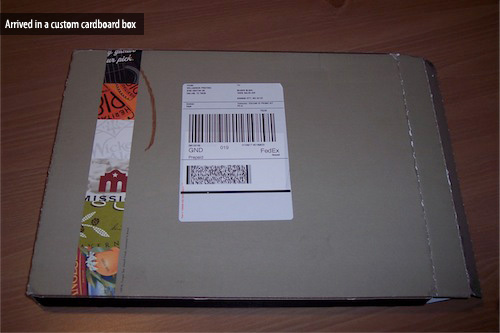
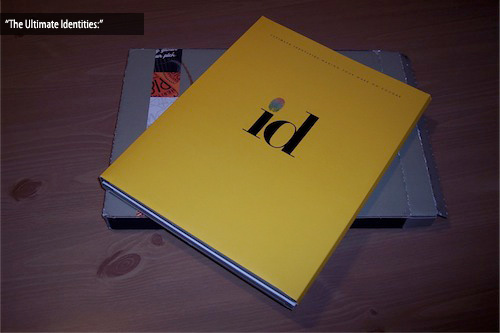
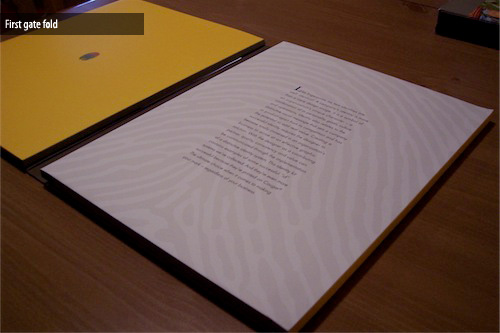
With this folder, Domtar is stressing the importance of brand/identity. If you print on their paper your stuff will be sweet. They’ve included 6 examples of companies that printed their identity on the Cougar line of paper.
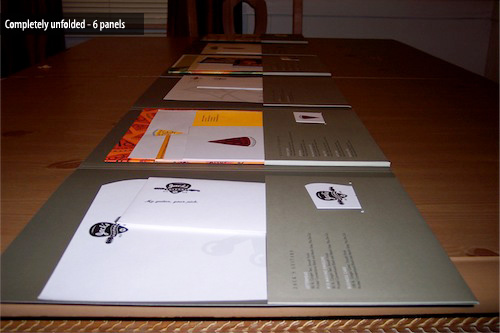
What sticks out to me even more than the layout of this 6 panel folder is the company featured in the 3rd panel from the right: OrangeSeed Design.
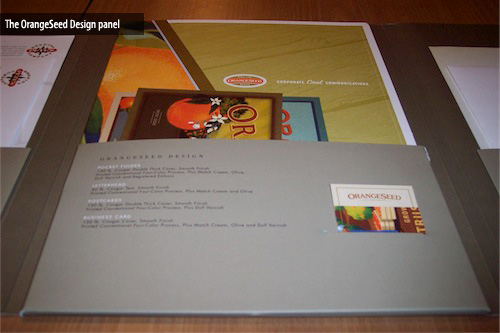
What is so impactful about OrangeSeed’s printed identity is the creativity and thought they put into each item. Their stationary is fun, professional and makes the client trust their ability to pull off great work. But that’s not all.
I have to admit that one of the most powerful elements to OrangeSeed’s identity is the paper it’s printed on.
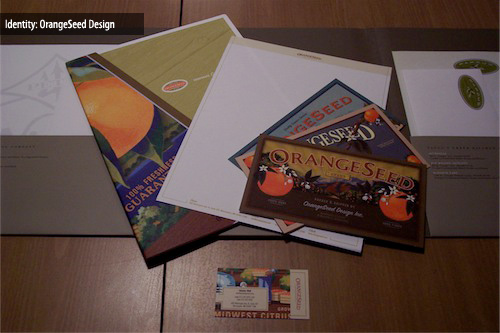
The pocket folder has a spot for letters, samples, proposals, and more; as well as plenty of white space for notes. It’s well thought out and is printed on 130 lb. paper. The letterhead is printed on 80 lb.
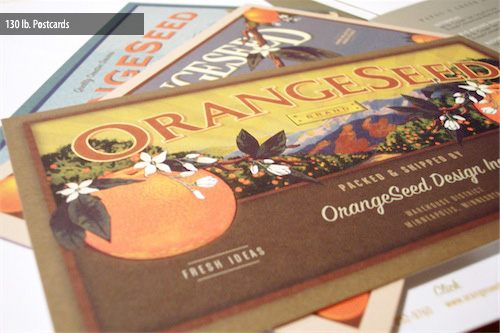
They have also designed printed custom postcards to mail to clients. These also are printed on 130 lb. paper.
Very few words are needed to convey importance and even reverence to the recipient.
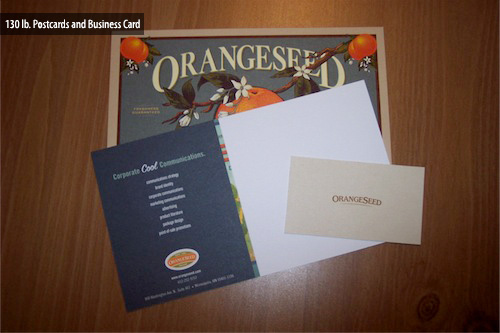
Their business card is also printed on 130 lb. card stock.
It is amazing to me a company’s printed identity can make such an impact.
I find that I would much rather design a great piece of work that really touches even just a small handful of people – something that inspires them to greatness and beauty – much more so than being able to point out to all my friends that – “Hey! I made that Budweiser Bill Board.”
The Dan Pitts Interview
Dan Pitts – like many of us – works a 9 to 5 and does freelance on the side. He’s a great guy and does some equally great work. His freelance gig flys under the name of e210 Design.
One thing I love about Dan is his passion towards design. On his bio he says, “Design is more than making something that looks great or sells, it’s a way to encourage and serve the client.”
There are many designers out there whom are creating with no purpose or passion behind their work. Dan on the other hand is really seeking to enhance his own art, and bring something quality and worthwhile to the design community.
I had the chance to ask him some questions about the work he does and (of course) the Mac he does it on. Enjoy.
- SHAWN BLANC: Hey Dan. Tell me about what you do that your bio page doesn’t say.
- DANN PITTS: Currently I’m working a full time job that I have had for 9 years now. At my 9-5 we focus on catalogs and gift books with some book covers. After my first son was born I found that my creativity (and my wallet) needed a boost so I went out to find some different kinds of work. So for the past four years I’ve built up a network of clients and other designers and have gotten to the point where I have steady work coming in. I am limited to how much and what kind of work I can do since I usually have to work at night. I have chosen to focus on book cover and web design. I’ve found that variety really brings a joy to designing and a boost to creativity.
- SHAWN: When you first stepped into freelance design work on the side what was the biggest challenge you faced?
- DAN: The quick answer is finding work. The details of that answer is that I had to set up a website portfolio that I could point people to. Problem was I didn’t have much work (and no book covers) to post. At the time I didn’t put anything from my 9-5 on there and all I had were a couple logo’s I had done for friends and a website I had worked on for our church. So I had to create my website (which has been the hardest client I’ve worked for) and then create these covers that were going to show what I could do. I kept running into a wall where I felt they just weren’t good enough or could be improved but eventually I just had to get the site posted and some covers up to start the process. Looking back they were pretty weak but you have to start somewhere. Thankfully for me the first batch of emails I sent out looking for work produced a client I really enjoy working for and they have sent me many projects so now I can post actual work.
- SHAWN: Why Book Covers?
- DAN: First, I was already doing it at my 9-5 job so I had some experience in it. Second, from a business standpoint it’s really a great niche, if you can get in with a publisher and they like your stuff they will probably give you repeat work. Most important for me is that it’s a single piece of art and it’s goal is to catch your attention and lead you into the book. So each book is a new challenge with new solutions and is inspired by the work someone else has done so it kind of has that team aspect to it. I also like the finality of being able to see a project that is printed (as opposed to the web work I do).
- SHAWN: Why Web Design?
- DAN: Well web design is obviously the future, if the future isn’t here already. The ability to communicate information on the web is so amazing, I wonder if we don’t take it for granted already (and I’m still amazed when I run across companies that don’t have a site or they have a bad one and it’s not a priority for them). It’s relatively inexpensive and can be so current you can do things you could never do with print; podcasts, video podcasts, pdf documents you can download, it’s all so amazing.Then to think that the only thing that changes between the fortune 500 company and a church website or a small business of 4 employees is the content, that makes the design that much more important. I’m comparing it to print where a major company might print something out on a huge press run with high weight, glossy paper, special inks, embossed and a church is making black and white copies in there office. Not with the web, each site is viewed on the same computer with the same browser.
- SHAWN: If web design is the future, what do you think that will mean for print?
- DAN: Well there are people with a lot more experience and knowledge that I would look to for that answer but here’s my take.I’ve seen it effect some areas of print already. My 9-5 job, one of their main clients is a catalog company and the web has effected their business dramatically. I don’t know if print will ever go away but I think it will serve more and more as a way to lead people to websites. Print can never keep up with the web when it comes to current content, but there is something to be said for the ability to hand someone a business card rather than sending an email.
For books, I have a hard time imagining the day when a 200-400 page book is sold in an electronic format and tens of thousands of people buy it. I know some of the reference books I have worked on come with a cd that has the information in pdf format also but that is an extra aid, not the main product. Even writing this though I have that feeling that if I see this in 15 years I will look back and laugh.
Who knows, I guess that’s why I try and have my feet in both.
- SHAWN: That’s a great answer. I think the concept of using print to point to web is excellent. This allows for more focus on design with printed material, allowing the content to be primarily web-based.Changing topics a little bit. Let’s talk about your workflow. For starters what does your Mac setup consist of?
- DAN: Right now I’m nearing the end of a good run with my G4 20 inch imac, 160gb hard drive with 1gig memory. I’m in need of upgrading the programs and computer but here’s a screenshot of what I’m using now.
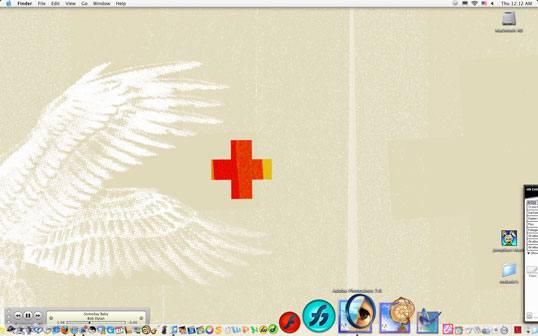
- SHAWN: What other Apple gear have you used?
- DAN: I remember my dad getting one of the first macintosh computers for christmas when I was younger. In high school that’s all I used and in college being a fine arts major I didn’t have to use the computer a whole lot so I always found the mac lab, just happened to pick the right profession I guess.I started freelancing on the first generation imac, went to a G3 powerbook with a seperate monitor (the 21 inch apple crt’s which weighed about 200 pounds). Then got a hand me down G4 titanium powerbook from my dad before the imac. The imac has been with me the longest.
- SHAWN: I have always loved the titanium PowerBooks. I remember when they first came out. That was actually my first time in an Apple store. They will always be a classic to me.So when you do a freelance project for print, like a book cover, what does your workflow look like?
- DAN: Right now it’s usually make client calls on my way home from work. Then after being a father and husband for a while I start working around 9 or 10.I’ll start by sketching out stuff on paper and trying to ask, what problem am I trying to solve. Then I’ll look at websites or books, try to gather information, scans or images I might want to use, nice fonts, anything. Then if possible I like to let that kind of soak in and have a direction before I start working on the computer. Usually that direction will then move into other ideas but I found that if I don’t have a place to start and focus I can go anywhere and waste a lot of time on ideas that don’t work.
An important part of my workflow seems to be the time that elapses between sending the first round out and then getting the corrections back. I like having that time to detach from the project and come back with fresh eyes, and usually the art director will narrow it down to what comp they want to work on. I have to refine and keep polishing it. I hope time and experience will change that a bit and I can provide great stuff first round, but I have a ways to go still.
- SHAWN: So if you work a 9-5, and do freelance work starting around 9 or 10, how much sleep do you normally get?
- DAN: Sleep? Usually if work is moderately busy I’ll get 5 hours a night. If it’s really busy maybe around 4. I’m not one of those guys that can pull an all nighter (not even when I was in college).At a certain point my eyes just stop working and I have found that I’m not really productive anyways. No matter how much Mountain Dew I drink. I could handle it better when we just had our son but now I have twin girls (a year and a half old) and it’s been much harder. Every now and then I need to go to bed at 10:30.
- SHAWN: I bet that’s something we can all relate to.